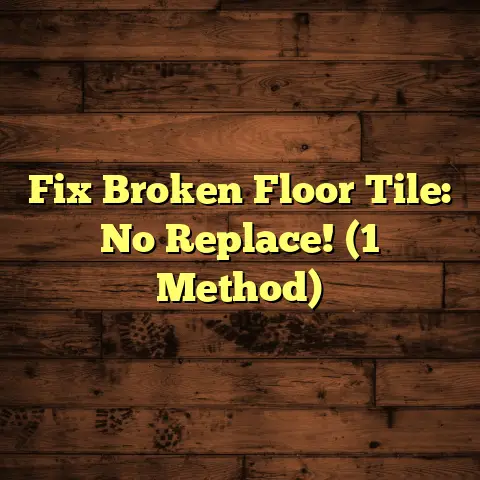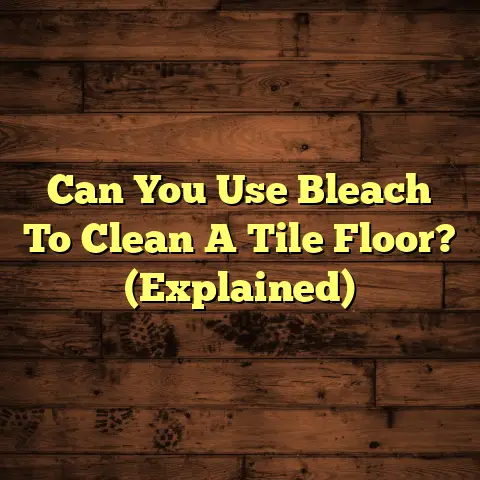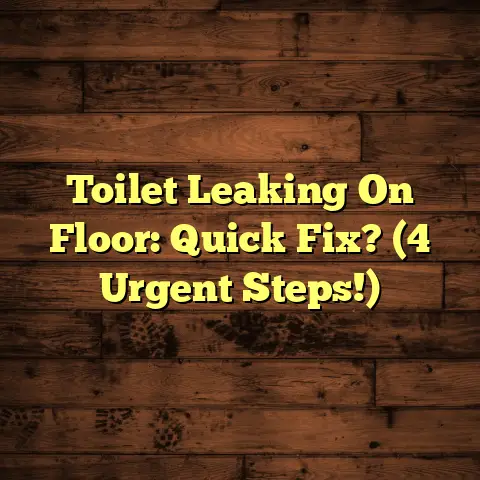Flooring Under Toilet: Yay or Nay? (1 Mistake!)
Ever walk into a bathroom and get that nagging feeling something isn’t quite right?
Maybe it’s that tiny gap between the toilet and the floor, or perhaps it’s the unsettling thought of what might be lurking underneath.
I get it.
I’ve been in the flooring business for over 15 years,
and I’ve seen it all – the good, the bad, and the downright
ugly when it comes to bathroom flooring.
Today, we’re diving deep into a question that plagues many homeowners: Flooring under the toilet – yay or nay?
And I’m going to reveal the one crucial mistake that
can turn this seemingly simple decision into a costly
nightmare.
So, grab a coffee, settle in, and let’s get
down to business!
Understanding the Basics of Toilet Installation
Let’s start with the fundamentals.
A toilet, quite simply, is the porcelain throne of our
homes.
It’s essential for hygiene, comfort, and, well,
you know.
But how does it all work?
Toilets are typically installed on a flange, which is a circular fitting attached to the drainpipe in the floor.
The toilet is then bolted to the flange, and a wax ring is placed between the toilet base and the flange to create a watertight seal.
Now, here’s where flooring comes into play.
Ideally, the flooring should be installed before the
toilet is set in place.
This ensures a seamless, continuous
surface that protects the subfloor from moisture.
But, as you might have guessed, things don’t always go according to plan.
We have different flooring types which are:
-
Tile: Durable, water-resistant, and a classic choice for bathrooms.
-
Vinyl: Affordable, easy to install, and comes in a wide variety of styles.
-
Laminate: A budget-friendly option that mimics the look of hardwood but isn’t as water-resistant as tile or vinyl.
The Importance of Flooring Under a Toilet
Why all the fuss about flooring under a toilet anyway?
Well, let me tell you, it’s more important than you might think.
Without proper flooring underneath, you’re essentially leaving your subfloor vulnerable to water damage.
Think about it: toilets can leak. Wax rings can fail.
Kids can splash water everywhere (trust me, I know!).
And if that water seeps into the subfloor, you’re looking at a recipe for mold, rot, and structural damage.
And believe me, I’ve seen the aftermath firsthand.
I once had a client who skipped the flooring under their toilet during a quick bathroom remodel.
A few months later, they noticed a musty smell and a soft spot in the floor.
Turns out, a slow leak had been festering under the toilet, causing extensive damage to the subfloor.
The repair bill?
A whopping $3,000!
Not to mention the inconvenience and disruption of having their bathroom torn apart.
And it’s not just about water damage.
The absence of flooring under a toilet can also affect your home’s resale value.
Potential buyers might see it as a sign of neglect or poor workmanship, and it could raise red flags during a home inspection.
According to a 2023 survey by the National Association of Realtors, bathrooms are one of the most important rooms for homebuyers.
A well-maintained bathroom with proper flooring can significantly increase your home’s appeal and value.
The Aesthetics vs. Practicality Debate
Okay, let’s be real.
Sometimes, we make decisions based
on what looks good, not necessarily what’s practical.
And I get it!
A beautiful bathroom can be a sanctuary, a place to relax and unwind.
But when it comes to flooring under the toilet, practicality should always trump aesthetics.
Sure, it might be tempting to skip the flooring to save time or money, or maybe you think it’ll look cleaner without it.
But trust me, the long-term consequences far outweigh any short-term benefits.
That being said, you don’t have to sacrifice style for
function.
There are plenty of flooring options that are
both beautiful and practical for bathrooms.
-
Large-format tiles: These create a sleek, modern look with fewer grout lines, making them easier to clean.
-
Luxury vinyl planks (LVP): LVP is waterproof, durable, and comes in a wide range of styles that mimic the look of wood or stone.
-
Porcelain tile: Extremely durable and water-resistant, porcelain tile is a great option for high-traffic bathrooms.
Common Mistakes Homeowners Make
Alright, it’s time to reveal the one crucial mistake that homeowners often make when it comes to flooring under toilets.
Are you ready?
It’s failing to properly seal the gap between the toilet base and the flooring.
I know, it sounds simple, right?
But you’d be surprised how many people overlook this crucial step.
They install the toilet, maybe caulk around the base, and think they’re done.
But here’s the thing: caulk can crack, shrink, and deteriorate over time, leaving gaps that allow water to seep underneath.
And once that water gets in, it’s game over.
Mold, mildew, and rot will start to thrive, and before you know it, you’re dealing with a major problem.
I remember one client who had beautiful new tile flooring installed in their bathroom.
They were so proud of their DIY skills, until they noticed a dark stain spreading around the base of the toilet.
Turns out, they had used a cheap, low-quality caulk that had cracked and allowed water to seep underneath.
The result?
A mold infestation that required professional remediation and a complete replacement of the flooring.
The cost?
Over $5,000!
So, how do you avoid this mistake?
-
Use a high-quality, waterproof caulk specifically designed for bathrooms.
-
Apply the caulk evenly and smoothly, ensuring a complete seal around the entire base of the toilet.
-
Inspect the caulk regularly and reapply as needed.
The Cost Implications
Let’s talk money.
I know, it’s not the most exciting topic, but it’s important to understand the cost implications of your flooring choices.
Installing flooring under a toilet might seem like an added expense, but it’s actually an investment that can save you money in the long run.
Think about it this way:
-
Cost of installing flooring under a toilet: $50-$200, depending on the type of flooring and the size of the area.
-
Potential cost of repairing water damage from a leak: $500-$5,000 or more, depending on the extent of the damage.
-
Cost of mold remediation: $1,000-$10,000 or more, depending on the size and severity of the infestation.
As you can see, skipping the flooring can end up costing you a lot more in the long run.
And it’s not just about the money.
Think about the time, stress, and inconvenience of dealing with water damage, mold, and repairs.
It’s simply not worth the risk.
According to a 2022 report by HomeAdvisor, the average cost of repairing water damage in a home is $3,216.
That’s a significant chunk of change that could be avoided by simply installing proper flooring under your toilet.
Different Flooring Options
Now, let’s explore some of the best flooring options for bathrooms.
I mentioned a few earlier, but let’s dive into more detail.
Tile: Tile is a classic choice for bathrooms for good reason.
It’s durable, water-resistant, and comes in a wide variety of styles, colors, and sizes.-
Pros: Waterproof, durable, easy to clean, and long-lasting.
-
Cons: Can be cold and slippery, requires grout sealing, and can be expensive to install.
-
Vinyl: Vinyl is a more affordable option that’s also waterproof and easy to install.
It comes in sheets, tiles, and planks, offering a variety of looks and styles.-
Pros: Waterproof, affordable, easy to install, and comfortable underfoot.
-
Cons: Can be susceptible to scratches and dents, and may not last as long as tile.
-
Laminate: Laminate is a budget-friendly option that mimics the look of hardwood.
However, it’s not as water- resistant as tile or vinyl, so it’s not the best choice for bathrooms that are prone to moisture.-
Pros: Affordable, easy to install, and looks like hardwood.
-
Cons: Not waterproof, can be damaged by moisture, and may not last as long as tile or vinyl.
-
Engineered Wood: Constructed from layers of wood veneer, engineered wood offers natural beauty with enhanced stability.
It’s less prone to warping or expanding in humid conditions compared to solid wood, making it suitable for bathrooms with proper ventilation.-
Pros: Real wood appearance, dimensionally stable, can be refinished.
-
Cons: More expensive than laminate, still susceptible to moisture damage if not properly sealed, limited water resistance.
-
Stone: Natural stone flooring, such as marble, granite, or slate, adds luxury and durability to a bathroom.
Each piece is unique, offering a distinctive look.
However, stone requires sealing to prevent staining and can be cold underfoot.-
Pros: Natural beauty, durable, adds value to the home.
-
Cons: Expensive, requires sealing, can be slippery when wet, cold underfoot.
-
When choosing a flooring material for your bathroom, consider your budget, your style preferences, and the level of moisture in your bathroom.
If you’re unsure which option is best for you, consult with a flooring professional.
DIY vs. Professional Installation
So, you’ve decided to install flooring under your toilet.
Now, the question is: should you do it yourself, or hire a professional?
Well, that depends on your skills, your tools, and your tolerance for risk.
If you’re a seasoned DIYer with experience in flooring installation, you might be able to tackle this project yourself.
However, if you’re a novice, I recommend hiring a professional.
Installing flooring under a toilet requires precision, attention to detail, and the right tools.
And remember that one crucial mistake we talked about?
Failing to properly seal the gap between the toilet base and the flooring?
A professional installer will know exactly how to avoid this mistake and ensure a watertight seal.
Plus, they’ll have the tools and expertise to handle any unexpected challenges that might arise.
According to a 2023 survey by Angi, the average cost of hiring a professional to install flooring is $6-$12 per square foot.
While this might seem like a significant expense, it’s worth it to ensure a proper installation and avoid costly mistakes.
Conclusion
So, there you have it.
Everything you need to know about flooring under toilets.
I hope I’ve convinced you that it’s not just a design choice, but a crucial element of bathroom maintenance and home value.
Remember, while aesthetics are important, practicality and long-term implications should always guide your choice.
Don’t make the one crucial mistake of failing to properly seal the gap between the toilet base and the flooring.
And if you’re unsure about anything, don’t hesitate to consult with a flooring professional.
Now, I want you to take a moment to reflect on your own bathroom setup.
Do you have flooring under your toilet?
Is it properly sealed?
If not, now is the time to take action and protect your home from water damage, mold, and costly repairs.
Thanks for reading, and happy flooring!





